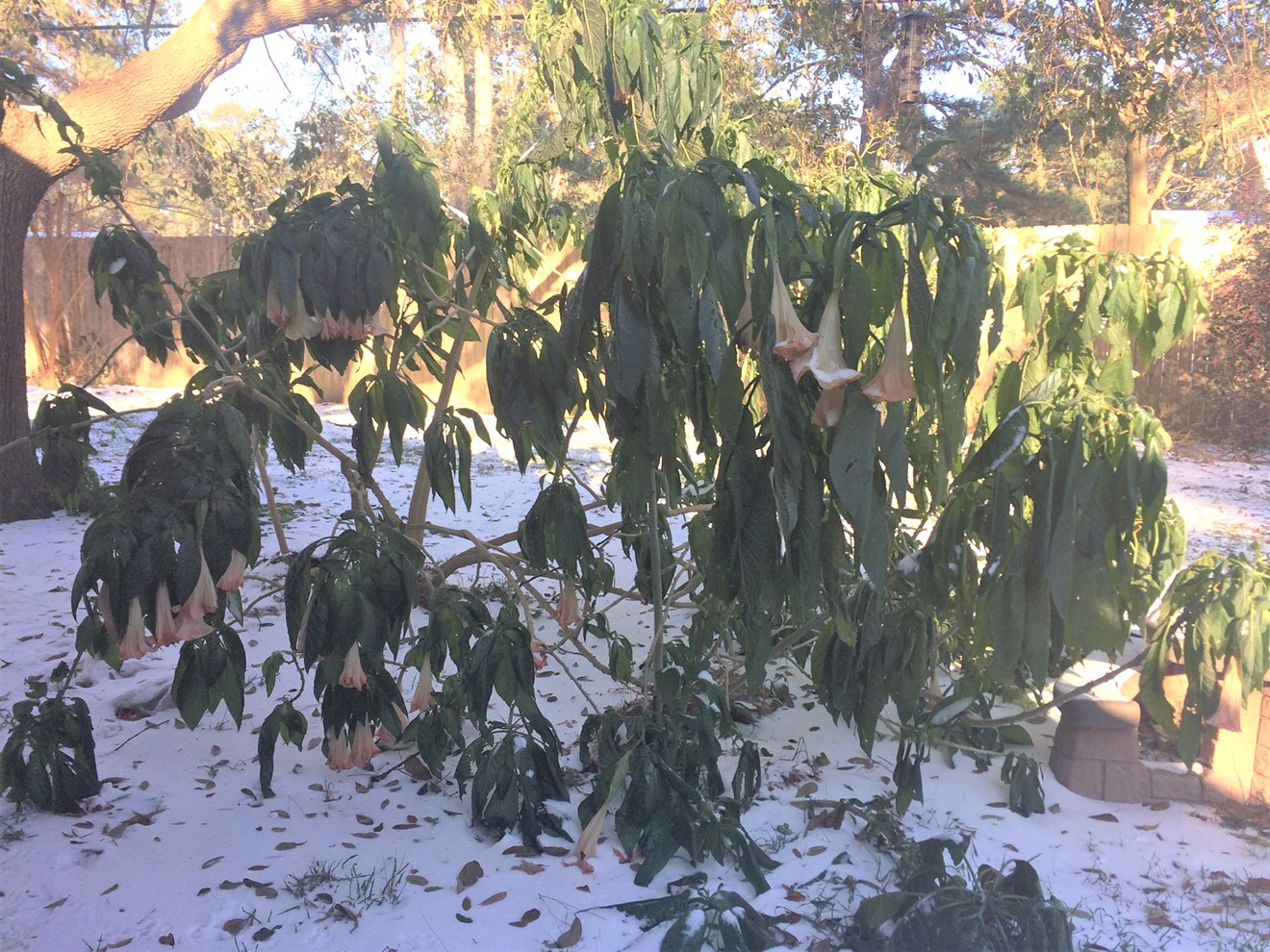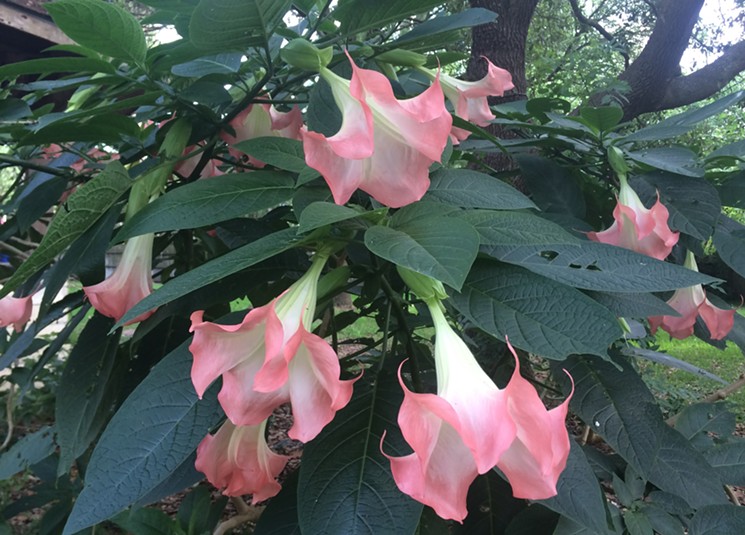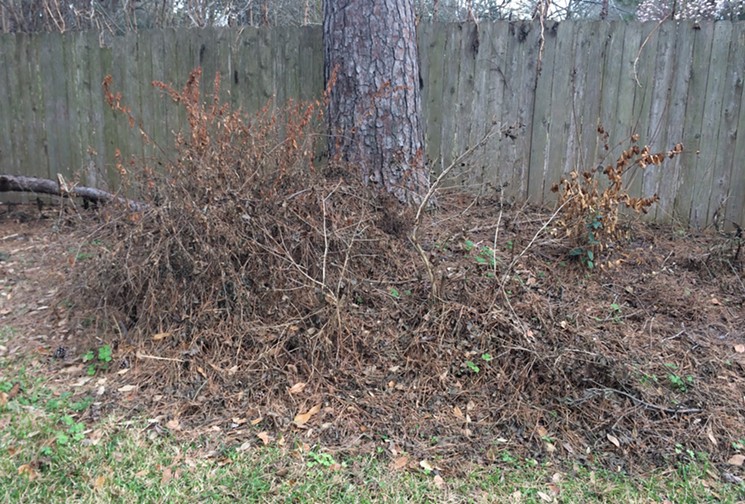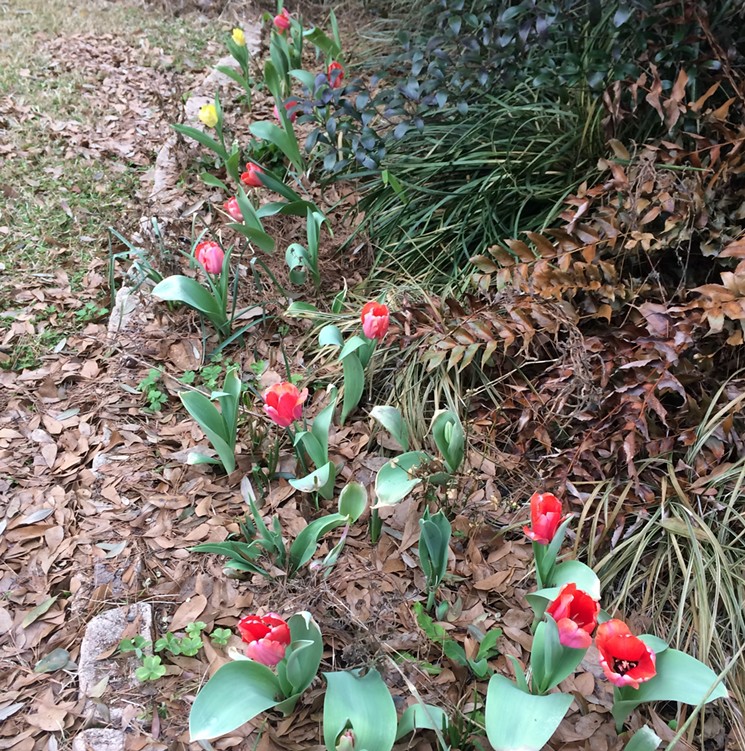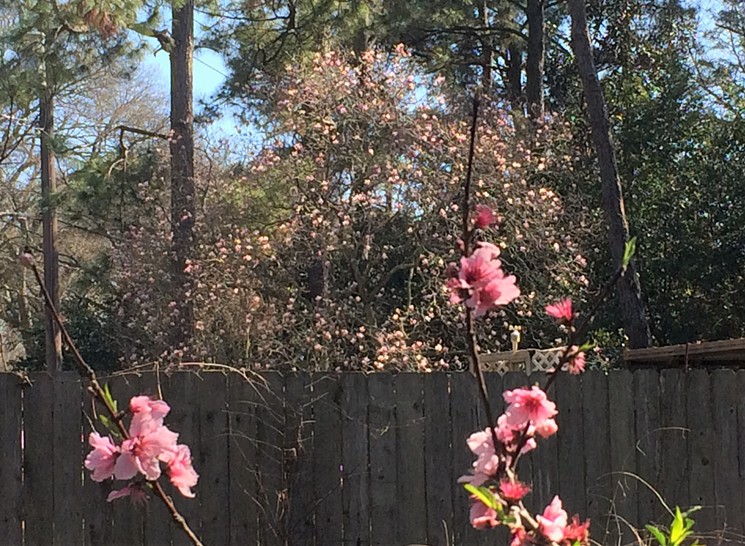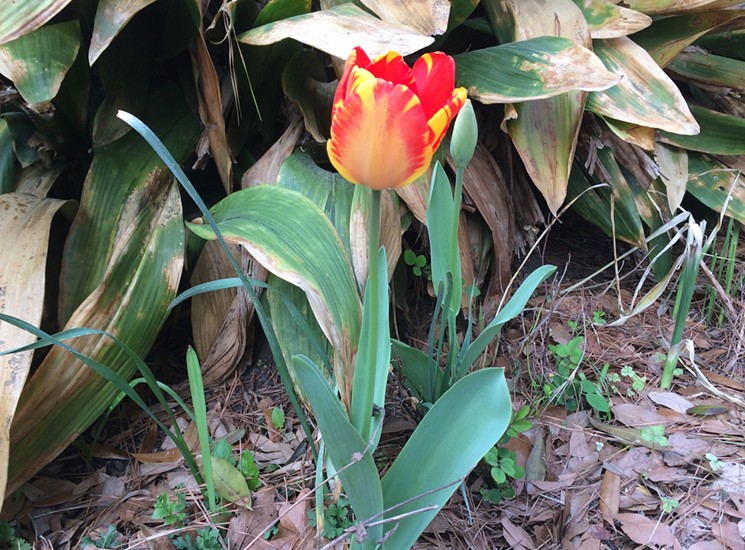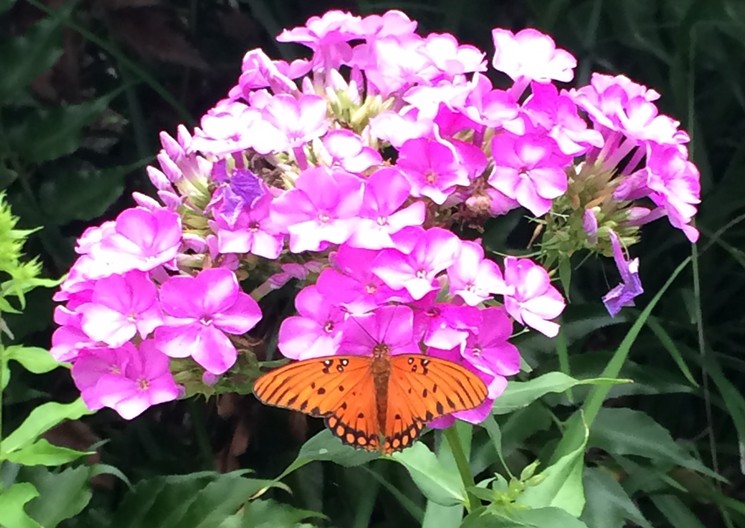The unprecedented winter storm that hit Texas on Valentine's Day was not wholly unexpected. The forecast for unusually cold temperatures in Houston had many of us scrambling to wrap our pipes and stock up on comfort snacks. For Houston gardeners, however, it meant a last look at our budding fruit trees and tropical plants that had enjoyed several winters without a hard freeze.
I was one of those depressed gardeners. I spent several hours in my backyard sipping wine and staring at my humongous, blooming Angel's Trumpet (brugmansia) and my climbing rose with its just-opening pink blossoms. I harvested the Japanese mustard greens that I had planted in the fall and some of the lettuce. I dug up the root-bound peach tree that had grown through its plastic pot and into the ground, accidentally cutting off one of its main roots. Still hoping for its survival, I dragged it in a storage tub into the garage. My family was recruited into hauling the multitude of potted plants into the house, leaving dirt and leaves everywhere.
Houstonians woke up February 15, 2021 to a snow-covered world resembling a New England landscape more than a Bayou City. My family had snowball fights, the dogs rolled in the snow and we shared winter wonderland photos online. I almost forgot about all the foliage that was suffering under the pretty, white snow. And then, I became more concerned about the human beings that were beginning to suffer as Facebook posts and phone calls alerted us to our friends and families dealing with power outages, a fate we were fortunate to escape the entire storm. However, on February 16, a pipe burst in our ceiling, taking out part of the master bedroom ceiling and carpet in two rooms. We then joined many others in melting snow for toilet-flushing and taking sponge baths from a boiled pot of water, glad that we still had heat and electricity.
After all of the struggles many of us faced during that time, it seems trivial to complain about dead plants and shrubs. And I certainly believe people and animals are far more important. But, as a gardener, there's a feeling of sadness to see years of labor destroyed by a few days of freezing temps. For many home owners, it's also a huge financial loss. It takes a lot of money and time to get plants large enough to anchor a home's front lawn or to offer privacy from the neighbor's house.
For some it's a more emotional loss. Gardeners who have collected plants for years become quite attached to their botanical babies. Some of us have plants that have been passed down from grandmothers or given to us by now-gone friends. Twenty years ago, when we lived in Oak Forest, I stopped to admire a huge display of Yesterday, Today and Tomorrow (brunfelsia) along Ella Boulevard. I told the elderly woman who lived there how much I admired it. She invited me in for coffee, gave me several clippings of the plant and a dozen eggs from her backyard chickens. I have planted it at two different houses since then. At our current house, it had gotten quite large. I covered it before the freeze but it did no good. Still, I have hope that it will recover. It has a story.
This is the time of year when the azaleas, Bridal Wreath spirea and brugmansia would usually make a stroll around our streets a colorful pleasure. Now, it's a sea of brown and yellow. My fifty-year-old neighborhood looks like a Sago Palm ghost town. That particular plant must have been the plant du jour in the 1970s. One of our garden club ladies said I should get Yard of the Month because the tulip bulbs I had planted in early January had popped up red and yellow through all the dead foliage, one of the few things blooming in the neighborhood.
The winter storm just seemed another terrible event in a terrible year. Many Americans have spent more time gardening and doing home improvements since the pandemic began. It's a form of nesting. Some Houstonians had already begun landscaping their yards in early February, enjoying the mild temperatures unaware that devastation was around the corner. And while we know that it is a gamble, some of us were already preparing to start our vegetable gardens. Last year, I planted a number of veggies and sowed seeds the first week of February. That year, the gamble paid off. This year, I rolled snake eyes.My fifty-year-old neighborhood looks like a Sago Palm ghost town. That particular plant must have been the plant du jour in the 1970s.
tweet this
A recent mosey around my front and back yards revealed that all is not lost, by any means. My neighbor's Tulip Magnolia tree was just starting to bud when the winter storm happened. I thought the freeze would damage the new blooms. Though not as glorious as some years, it still is a welcome sight from my patio. The peach tree that I treated so shabbily has been released from its garage darkness and is safely in-ground and blooming prolifically. My Angel's Trumpet is a goner but it may come back up from the roots. I started four cuttings from it this past January after a high wind broke off a branch. Now, I have little ones to take its place. My azaleas don't look so hot but I will give them time. The LSU Purple fig tree that I had thought about planting in the ground this year is bursting with new leaves after it spent a week in my laundry room. Maybe I will take a chance on planting it this year. Or maybe not. It's another gamble.
My own Sago Palm, a plant that I have little affection for, has been trimmed of its dead fronds, a chore I left to my husband. It will most likely arise from the ashes, especially since it has pups around its base. The huge Oleander next to it looks scorched but it may come back. However, I am considering doing away with it altogether. My husband hates the leaves it regularly drops and my teenage son complains about having to retrieve his basketball from within its many limbs. That, coupled with its proximity to the Sago and the Queen Elizabeth rose bush means that he and his friends have experienced a few scrapes over the years chasing after a ball that has bounced into the morass. After we finish trimming everything, we may find one of his friends from middle school still in there.
There's a positive side to a garden upheaval. It forces us to make landscape choices that we may have put off for years. It gives us a clean slate to start over with plants that we actually love not just put up with because they were already there when we moved in. We get the opportunity to create a landscape that reflects ourselves. Some like ostentatious tropicals, others prefer Zen minimalist gardens. Smart Texans will go native with plants that thrive no matter what. Me, I am a mish-mash gardener, with hand me-downs, clearance buys and unpruned monsters. This freeze may make me choose more cohesion and structure in my plantings. But I doubt it.
It will take some time to get our yards back to their pre-Uri beauty. There will be some grieving over heirlooms and favorites that didn't make it. For many of us, the landscaping will have to take a back seat to buying new flooring and repairing sheetrock from burst pipes. And there's still the pandemic with its own stressors and griefs.
Yet, people are still having babies. Dogs and cats are still getting adopted. And Houston gardeners are still taking chances on planting new citrus trees or heat-loving hibiscus. We have seen a number of weather-related disasters in the past few years and will certainly experience more in the future. We always rebuild and replant.
So, if life knocks you down, stay there for a while and dig in the soil. Something new will grow.
Next week, we will give tips on how to get growing again.

